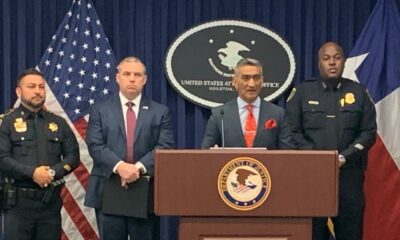Kaiser Health News
Proposed PFAS Rule Would Cost Companies Estimated $1B; Lacks Limits and Cleanup Requirement
by Michael Scaturro
Mon, 10 Jul 2023 09:00:00 +0000
A proposed federal rule calls for forcing companies to disclose whether their products contain toxic “forever” chemicals, the government’s first attempt at cataloging the pervasiveness of PFAS across the United States.
The Environmental Protection Agency rule would require manufacturers to report many products that contain perfluoroalkyl and polyfluoroalkyl substances. They’re a family of chemicals that don’t degrade in nature and have been linked to cancer, birth defects, and hormone irregularities.
Companies would have to disclose any PFAS that have been manufactured or imported between 2011 and when the rule takes effect, with no exemptions for small businesses or for impurities or byproducts cross-contaminating goods with PFAS. Those disclosures would be available to the public, barring any trade secrets linked to the data. The EPA will finalize the rule in the coming months, agency spokesperson Catherine Milbourn said, then require companies to report back within 12 months.
The effort excludes pesticides, foods and food additives, drugs, cosmetics, and medical devices regulated under the Federal Food, Drug, and Cosmetic Act, Milbourn said. It also is essentially a one-time reporting and record-keeping requirement — and companies wouldn’t need to provide updates.
Still, the chemical and semiconductor industries are grumbling about what the EPA estimated is a potential $1 billion cost to comply with the rule. The U.S. chemical industry says it generates more than $500 billion annually.
On the other side, environmental health activists say the data collection exercise would be flawed, as it accounts for only a tenth of the more than 12,000 PFAS chemicals, which are used in everything from nonstick cookware to kids’ school uniforms. Moreover, they say, it wouldn’t stop PFAS from making their way into the air, waste, or consumer products, nor would it clean up existing contamination.
Congress gave the EPA the power to track PFAS chemicals in 2016, when it revised the Toxic Substances Control Act. Then a bipartisan effort in 2019, which President Donald Trump signed into law, called for the EPA to inventory PFAS. However, health activists warn that unless Congress overhauls U.S. chemical laws to give the EPA and other agencies more power, PFAS will continue to threaten humans and the environment.
These so-called forever chemicals went from marvel to bête noire in just 50 years. When PFAS debuted, they were revered for making Teflon pans nonstick and Gore-Tex jackets waterproof. They are effective at repelling water and oil yet so durable they don’t break down in the natural environment. That strength has become their downfall, as the chemicals accumulate in landfills, soil, drinking water supplies, and, ultimately, human bodies. As scientists learn more about PFAS’ toxic nature, governments around the world have set limits or imposed outright bans.
Because PFAS are found in thousands of products — contact lenses, cosmetics, pharmaceuticals such as Prozac, paper plates, clothing, and dental floss, to name just a few — regulators are scrambling to gather data on the scope of the PFAS threat. The EPA data collection proposal is a move in that direction.
Milbourn told KFF Health News that 1,364 types of PFAS may be covered by the rule, and EPA officials are reviewing public comments they received to determine whether they should modify its scope to capture additional substances.
By contrast, the European Union is discussing banning or limiting 10,000 PFAS chemicals, according to Hanna-Kaisa Torkkeli, a spokesperson for the European Chemicals Agency.
“In the U.S., chemicals are innocent until proven guilty,” said Kyla Bennett, director of science policy at Public Employees for Environmental Responsibility, a nonprofit based outside Washington, D.C. “In the EU and Japan, chemicals are guilty until proven safe — and that’s why they have fewer PFAS.”
That lack of regulation in the U.S. is driving states to take matters into their own hands, pursuing PFAS bans as gridlock and industry lobbying in Washington thwart tougher federal laws. Minnesota’s crackdown on PFAS limits the chemicals in menstrual products, cleaning ingredients, cookware, and dental floss. Maine’s law will ban all avoidable uses of PFAS by 2030. Vermont and California ban PFAS in food packaging.
“The states are acting because our federal system doesn’t currently allow the government to say ‘no more use of PFAS,’” said Liz Hitchcock, director of the federal policy program at Toxic-Free Future, a national advocacy group. “And even if it did, that wouldn’t clean up the mess already made.”
U.S. courts are also weighing in on PFAS contamination. On June 22, 3M agreed to pay up to $12.5 billion to settle lawsuits by communities around the country that argued their drinking water was contaminated by the company’s PFAS-containing products.
Additionally, the U.S. military is moving to limit PFAS, after a report said more than 600,000 troops were exposed to the toxic chemicals in drinking water contaminated largely by PFAS-laden firefighting foam.
Just cleaning up PFAS waste at U.S. military bases could cost at least $10 billion. Removing it from U.S. drinking water supplies could add more than $3.2 billion annually to the bill, according to a report commissioned by the American Water Works Association.
“The CDC estimates that 99% of Americans have PFAS in their blood,” said Melanie Benesh, vice president of government affairs for the Environmental Working Group, a nonprofit that researches the ingredients in household and consumer products. “We estimate that 200 million Americans are exposed to PFAS in their drinking water right now.”
Officials with the U.S. Geological Survey released a similar finding July 5 when they announced that the agency’s researchers estimate more than 45% of U.S. tap water is contaminated with at least one PFAS chemical after they conducted a nationwide study of water samples.
As ubiquitous as PFAS are, the reason they haven’t generated more outrage among the public may be that the damage from PFAS chemicals isn’t immediate. They affect health over time, with repeated exposure.
“People aren’t getting headaches or coughing from exposure to PFAS,” Bennett said. “But they are getting cancer a few years down the line — and they don’t understand why.”
Some environmental health advocates, such as Arthur Bowman III, policy director at the Center for Environmental Health, say the EPA’s data collection project could help. “It will be fairly straightforward for the EPA to gather PFAS information on cleaning products and other wet chemicals that contain PFAS,” Bowman said. “And this will lead to phaseouts of PFAS.”
Some retailers, such as Dick’s Sporting Goods and REI, have recently announced plans to remove the chemicals from many of their products.
But Bowman said it will be more difficult for manufacturers to remove PFAS used in the production of semiconductor chips and printed circuit boards, since alternative products are still in the research phase.
The Semiconductor Industry Association has asked the EPA for an exemption to the proposed reporting requirements because, it maintains, semiconductor manufacturing is so complex that it would be “impossible, even with an unlimited amount of time and resources, to discern the presence (if any) of PFAS in such articles.” Other industries have also asked for waivers.
The American Chemistry Council, which represents large PFAS manufacturers such as 3M, disagrees with those calling for the entire class of PFAS chemicals to be banned. “Individual chemistries have their own unique properties and uses, as well as environmental and health profiles,” said Tom Flanagin, a spokesperson for the trade group.
While the council’s member companies “support strong, science-based regulations of PFAS chemistries that are protective of human health and the environment,” Flanagin said, the rules shouldn’t harm economic growth “or hamper businesses and consumers from accessing the products they need.”
For their part, some environmental advocates welcome the reporting proposal, expecting it to reveal new and surprising uses of PFAS. “However, it’s going to be a snapshot,” said Sonya Lunder, the senior toxics policy adviser for the Sierra Club.
Lunder said even if PFAS were found in, for example, brands of baby bibs, pesticide containers, or pet food bags, it isn’t clear which federal agency would regulate the products. She said Americans should demand that Congress add PFAS and other harmful chemicals to all major environmental statutes for water, air, food, and consumer products.
And another worry: If the data does make it into the mainstream, will consumers simply tune it out — just as many do with California’s multitudinous cancer warning signs? Lunder doesn’t think so, since “the audience is scientists, regulators, and — for better or for worse — tort attorneys.”
Benesh, of the Environmental Working Group, said the disclosures could reach further and “embolden consumers to demand even more market change.”
By: Michael Scaturro
Title: Proposed PFAS Rule Would Cost Companies Estimated $1B; Lacks Limits and Cleanup Requirement
Sourced From: kffhealthnews.org/news/article/epa-pfas-rule-disclosure-forever-chemicals/
Published Date: Mon, 10 Jul 2023 09:00:00 +0000
Kaiser Health News
A Closely Watched Trial Over Idaho’s Near-Total Abortion Ban Continues Tuesday
SUMMARY: In a trial in Boise, Idaho, physicians and four women are challenging the state’s near-total abortion ban, arguing it endangers women’s health by forcing them to carry fetuses with fatal anomalies or endangering their lives without medical intervention. The case, which aims to introduce medical exceptions into the current law, highlights personal testimonies of severe pregnancy complications. Opposing counsel criticized the plaintiffs’ testimonies, framing abortions negatively. Advocates fear that a loss in this case could limit future challenges to similar bans nationwide. The trial follows previous legal setbacks in Idaho and Texas regarding abortion rights.
The post A Closely Watched Trial Over Idaho’s Near-Total Abortion Ban Continues Tuesday appeared first on kffhealthnews.org
Kaiser Health News
Social Security Tackles Overpayment ‘Injustices,’ but Problems Remain
SUMMARY: In March, Social Security Commissioner Martin O’Malley addressed systemic issues within the agency regarding overpayments that have harmed vulnerable beneficiaries. Although he has made some progress, including reducing full benefit withholding from 46,000 to about 7,000 recipients, challenges remain, such as the burden of proof still resting on beneficiaries to dispute overpayment claims. Advocates urge the need for a statute of limitations on recovery efforts, as cases can date back decades and cause severe financial hardships. O’Malley’s term is nearing an end, and while improvements have been noted, many beneficiaries still face difficulties within the system.
The post Social Security Tackles Overpayment ‘Injustices,’ but Problems Remain appeared first on kffhealthnews.org
Kaiser Health News
Pay First, Deliver Later: Some Women Are Being Asked To Prepay for Their Baby
SUMMARY: Kathleen Clark faced an unexpected $960 prepayment request from her OB-GYN during her pregnancy, a practice increasingly reported by pregnant women. Often, these upfront fees occur before the pregnancy concludes, creating financial strain and anxiety. Advocacy groups criticize this as unethical, arguing it can deter women from seeking necessary care. Although providers claim prepayments ensure compensation, the approach complicates billing and may force unwanted decisions on patients. With U.S. maternity care costs averaging nearly $3,000 out-of-pocket, many families struggle financially, raising concerns about equitable access to prenatal services. The issue remains challenging to regulate due to industry lobbying.
The post Pay First, Deliver Later: Some Women Are Being Asked To Prepay for Their Baby appeared first on kffhealthnews.org
-

 Our Mississippi Home3 days ago
Our Mississippi Home3 days agoCreate Art from Molten Metal: Southern Miss Sculpture to Host Annual Interactive Iron Pour
-

 News from the South - Florida News Feed5 days ago
News from the South - Florida News Feed5 days agoTrump taps Matt Gaetz as attorney general, Tulsi Gabbard as Intelligence official | National
-

 News from the South - Georgia News Feed3 days ago
News from the South - Georgia News Feed3 days ago'Hunting for females' | First day of trial in Laken Riley murder reveals evidence not seen yet
-

 Our Mississippi Home4 days ago
Our Mississippi Home4 days agoTraverse Whoville in Downtown Hattiesburg December 6th for Seuss-Themed Cookies, Stories, Family Fun and a Bit of Snow Thrown in for Good Measure
-

 Local News2 days ago
Local News2 days agoCelebrate the holidays in Ocean Springs with free, festive activities for the family
-

 News from the South - Alabama News Feed4 days ago
News from the South - Alabama News Feed4 days agoLofton takes stand in murder trial, testifies he wanted to shoot restaurant manager, not kill him
-

 News from the South - Alabama News Feed3 days ago
News from the South - Alabama News Feed3 days agoFirst woman installed as commanding officer of NAS Pensacola
-

 News from the South - Texas News Feed4 days ago
News from the South - Texas News Feed4 days agoISIS-linked Houston man indicted, planned 9/11 style terrorist attack | Texas




























